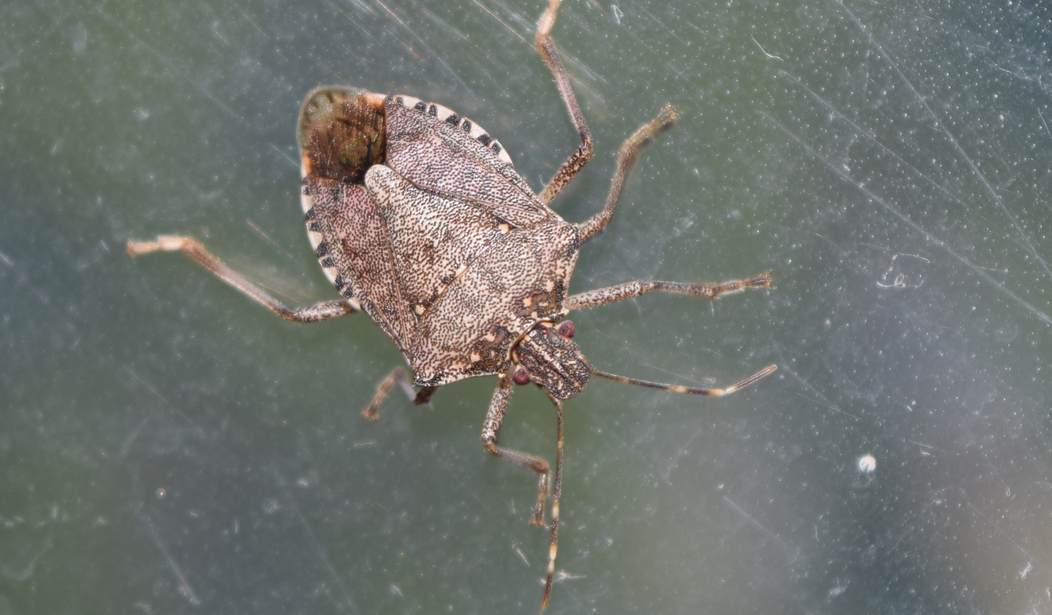Parts of the Midwest and Northeast are in the midst of a massive stink bug invasion. Ohio, Illinois, Michigan, Pennsylvania, Connecticut, and other states are reporting ongoing attacks by the nasty Asian imports — and they’re nearly impossible to eradicate.
MLive reported: “The brown marmorated stink bug, an insect that’s relatively new to Michigan, might be poised to cause some serious problems for our state’s agricultural industry. That’s on top of the nuisance these slow brown buggers are creating for homes this time of year, when the bugs seek out warmer environments as the weather cools.”
In Pennsylvania, CBS Pittsburg explains: “With fall now in full swing, the unwanted house guests are making their way indoors to escape the cooler temperatures.” The report goes on to note that “if they seem more prevalent, they are. Good Housekeeping says the annual migration is leading to larger numbers than ever before.”
Dave Shetler from The Ohio State University Extension Office says that he had three emails from “panicked homeowners saying their homes have been overrun.” And Extension agent Tim Malinich reported seeing “an arborvitae in Northeast Ohio that was covered so heavily with the bugs that it appeared to be moving.”
Connecticut resident Michael Pagani told Fox 61 that after moving into his house two weeks ago he noticed stink bugs flying around.
“My daughter, I got a 13-year-old she’s screaming all over the house and gets my son going and the dogs start barking and yeah, it’s a big pain in the butt,” said Pagani.
Sometimes referred to as the “skunks of the insect world” stink bugs arrived in the U.S. from Asia sometime in the ’90s, possibly in a shipping crate, and multiplied rapidly, spreading across the U.S.
While it might seem easy enough to kill them on sight, that’s not recommended because of the putrid odor they excrete when crushed or burned — or even annoyed. Some describe the smell as a cross between dirty socks and rotten cherries. To me, it smells like that syrupy sweet kitty litter-like stuff they used to put on puddles of vomit in school — after it’s been poured on the vomit.
Entomologist Dani Fischer said, “My dog ate one once when I was living in Yorkville, and the next thing you know was foaming at the mouth.” I can confirm that dogs hate these things. My yellow lab, who will eat just about anything not nailed down, runs away if he finds one on the floor.
In addition, the bugs are a menace to farmers, feasting on corn and soybean crops.
As I sit here writing this on my deck in Northeast Ohio, I’m swatting away stink bugs that are flying into my hair and clinging to my clothing — at a rate of approximately one every three minutes. I am not exaggerating. I’m very close to losing my ever-loving mind because of these little gray nasties:

This demon-possessed stink bug just landed on my leg.
This wretched thing just landed on my leg as I was sitting here typing. And then one landed on my computer and another on the back of my neck and at least three landed in my hair — my hand smells disgusting from swatting them away. My husband just spent the better part of an hour sucking them up with the Shop-Vac and drowning them, but it hasn’t helped. They’re still buzzing around me. It wouldn’t be so bad if they stayed outside, but they’ve also invaded the inside of our home.

My husband was walking around the house trying to catch the stragglers and found eight of them clinging to the back of the painting hanging over our fireplace. OMG!!!
After I awoke one morning with a stink bug crawling on my hand — in my freaking bed — I decided to call Orkin. They explained that they can mitigate the problem somewhat but they won’t be able to get rid of them completely. I was desperate enough that I plunked down hundreds of dollars to have them come every other month to spray. From their website:
They spend the winter hiding inside the walls or in the attic or crawl space. When spring comes, the stink bugs become active. As they begin to move around, some of them emerge into the living space.
Inside the home, the bugs often gather on walls and windows seeking a way out. Homeowners are usually upset to find these bugs inside the home. Their size and unpleasant odor make them very unwelcome.
I have to quibble with the part about them trying to get out. We’ve had stink bugs here for three years and I’ve never witnessed one trying to escape our home. On the other hand, they gather on the door frames waiting for an opportunity to get in. According to the EPA, “Aerosol and fogger type insecticides labeled for use against domestic stink bugs will kill these pests in living areas, but they will not prevent more of the insects from emerging from cracks after they dry.” They add that these products are “not a solution for long-term management of stink bugs.” But according to our Orkin guy, they don’t have any pesticides that will kill them—the best they can hope for is to deter them. Commercial pesticides are completely ineffective. I’ve completely doused them with two different kinds of Raid and they barely noticed it—they just got up and walked away.
The good news is they’re not eating anything in your house and probably not damaging anything. And now back to the bad news:
Here’s a severe infestation from 2012 that will give you an idea of what we’re dealing with here.
Yesterday, one day after Orkin came and allegedly “treated” our house for the wicked flying bugs, we had to remove at least two dozen of them from inside the house with my handy-dandy bug vac. (Did I mention that I’m being driven to the brink of insanity by these evil things?)
In addition to chemical treatments, the EPA recommends the following:
- Caulk windows inside and out.
- Weather strip entry doors and/or install door sweeps if daylight is visible around the perimeter of the door.
- Rake away all debris and edible vegetation from your home’s foundation to keep from attracting pests.
- Inspect for and seal foundation cracks to block a potential point of entry.
- Secure crawlspace entries.
- When insulating exposed plumbing pipes around the foundation or the crawlspace of your home, caulk small gaps and fill larger ones with steel wool.
- If your home has a fireplace, cap or screen the top of the chimney to keep out pests.
None of those things — including the Orkin treatment — put even a tiny dent in the problem. (Or maybe it has, and we’d have twice as many if we hadn’t done all these things?) The one thing that Orkin recommended that we haven’t tried is spending thousands of dollars replacing all the insulation in our attic with chemically treated insulation designed to deter them. (What’s the going price for sanity these days?) Orkin tells me they’ve been inundated with calls about stink bugs—almost everyone who calls is complaining about them. The dispatcher told me that she hasn’t been able to get rid of them at her house either.
The Internet is full of possible solutions including this video that shows how to construct a homemade trap:
This utterly failed at our house. Not only were the stink bugs not attracted to it, the one that I carried over and set on the trap didn’t bother climbing in. We left it out for two weeks and caught zero stink bugs.
We haven’t tried this one, but it looks promising:
The bugs are apparently attracted to the bright light and the sticky paper traps them. This man below, however, says you need an even brighter light—he recommends a 40-watt bulb:
If you’re able to catch them, you’ll need to dispose of the horrific buggers carefully unless you want the odor permeating your house for several hours. Whatever you do, do not crush or burn them. You can flush them, but be aware that they’ll leave behind the disgusting smell in your toilet. To be honest, I’m a little nervous about this tactic because I just know ours are multiplying—or maybe even mutating—in our septic tank. It seems like a plausible explanation for the massive infestation, right? Or it’s possible the insanity is setting in and I’m going to need a straight jacket soon. (I was sitting in church recently when a light buzzed above my head. I flinched, waiting for a stink bug to hit me in the head.)
Anyway, getting back to the subject of eradicating them, this guy says drowning them with soapy water is the way to go:
This man takes it a step further, spraying them directly with soapy water.
It might be worth a try if nothing else works.
Here are some additional tips from Bayer Advanced:
For outside your home
To prevent stink bugs from entering your home, block all points of entry. The same principles used to keep boxelder bugs from entering a home apply to stink bugs. Physical barriers provide the most effective long-term solution.
You can also apply an insecticide as a perimeter treatment outside your home. This method can block would-be insect invaders from entering your home for several days to a week.
Try these methods – which have been used successfully by homeowners and entomologists – to keep stink bugs at bay:
-
Rub screens with dryer sheets – the more pungent the better. Some homeowners have found this can reduce stink bugs entering a home by up to 80 percent.
-
Hang a damp towel over a lawn chair or deck railing overnight. In the morning, stink bugs will blanket the towel. Dispatch bugs in a bucket of soapy water.
-
Squish a few stink bugs outdoors. The odor warns other stink bugs to flee.
If you have an indoor infestation:
When stink bugs appear indoors, your options vary based on how many bugs you’re facing. What can you do?
- Don’t touch them directly or squish them.
- Stink bugs move slowly enough that you can catch them and deposit them outdoors in wintry climates (where they’ll freeze) or flush them into oblivion.
- Grab them gently with a plastic bag to avoid touching them directly.
- Take an empty water bottle and use the lid to flick the bug into the bottle. Tighten the lid to contain the smell, and place the whole thing outdoors. In cold climates, the bug will freeze. Re-use the bottle for more bug-catching.
- Prepare a soapy solution for killing stink bugs. Choose a straight-sided 1/2- or 1-gallon container. Fill it one-fourth full of water mixed with 1 teaspoon of liquid soap or detergent. When disturbed, stink bugs tend to drop downward. Knock them into the bucket from walls, draperies, screens, etc. Unable to escape, they will ultimately drown.
- Vacuum bugs, and empty the bag afterward. Don’t suck stink bugs into a bagless vacuum you use in your home. After vacuuming stink bugs, the vacuum will stink.
- Many homeowners in the worst-afflicted regions purchase small wet/dry vacs used solely for gathering stink bugs. Immediately after gathering bugs, dump the vacuum’s contents into a larger garbage bag and seal it tightly. Open the bag to add more bugs until garbage day arrives.
- Another technique to try is to wrap a knee-high stocking around the outside of the vacuum tube, secure it with a rubber band, and then stuff it into the tube. Stink bugs will be trapped in the stocking and won’t enter the vacuum filter. When you turn off the vacuum, careful remove the stocking, holding the end closed. Dump the captured stink bugs into a container of soapy water, as noted above, to kill the bugs.
- Do not apply insecticides indoors to control stink bugs. While insecticidal dust may kill bugs in wall voids, the carcasses can stink and attract other pests, such as carpet beetles, which can damage other things in your home. Applying an interior pesticide along baseboards won’t kill stink bugs nor will it keep them from emerging around the baseboards.










Join the conversation as a VIP Member